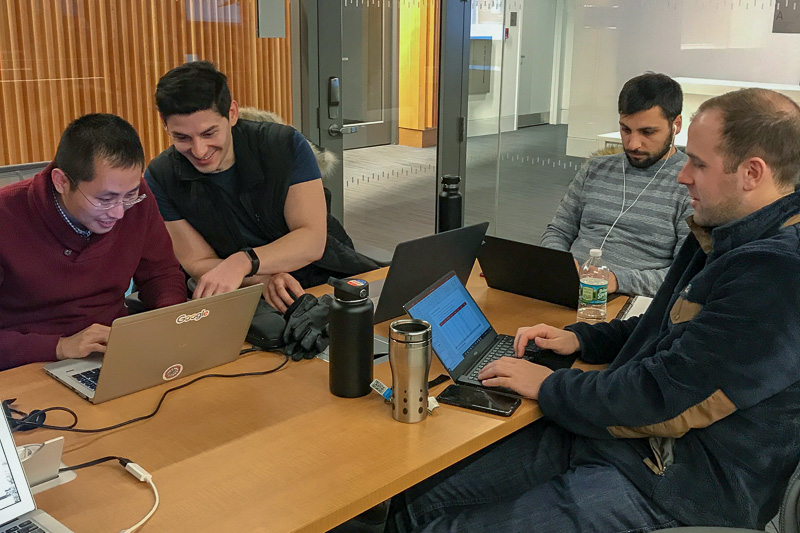2019’s first IBI case: Swimming in corporate debt

Sunset over Ithaca’s Cayuga Lake
By Alexandra Fey, Two-Year MBA ’20
Flash back to nine months ago, to an awesome Destination Johnson 2018. I remember speaking with now second-year students about Johnson’s Investment Banking Immersion (IBI). Their appreciation for the program was evident. The takeaway: the IBI is the best preparation you could imagine for a summer internship in investment banking. Get ready to jump into the deep end.
Flash forward to 8 a.m., January 21, 2019, the first week of the IBI for my fellow first years and me. My classmates and I were assigned to teams of four or five and given our first case: Bond.
The case
For this first assignment, we were tasked with the following: analyze a recently announced deal in the telecommunications industry, CommScope’s acquisition of ARRIS, and use the deal as a case study to provide an overview of the acquisition financing market to the CFO of a privately held communications equipment client, who wants your thoughts on her firm’s ability to finance a large transaction in the debt market.
Yikes.
Fortunately, since it was Week 1, Drew Pascarella, Rempe Wilson Distinguished Lecturer of finance and leader of the IBI, provided detailed guidelines on the key elements of our deck, which included:
- Situation overview
- Overview of today’s debt market (for both investment-grade and high-yield offerings)
- Recommendation on the size, tenor, and price/yield of the bond CommScope will need to issue to finance the acquisition
- Debt maturity profile
- Capital structure table for CommScope (prior and pro forma for the transaction)
Debt maturity profile? Tenor?
The IBI is brilliant, because during any summer internship, you will likely be tasked with an assignment you haven’t seen before. These cases challenge you and your team to figure it out—through research, discussion, and trial and error. You quickly learn to take advantage of the resources provided by the Johnson’s Management Library: Bloomberg, FactSet, Thomson One, CapIQ … and don’t forget Google!
Fortunately, several of my teammates had familiarity with Bloomberg and knew how to pull the needed data on the current state of the debt market. Research and a review of several sample pitch books online provided guidance on how to construct a debt maturity profile and capital structure table. Teamwork is absolutely a core component. Tackling the case alongside four of your classmates makes the mountain of work a little less daunting, and you have the opportunity to leverage one another’s skill sets, from PowerPoint to experience in finance and industry expertise. Moreover, Drew encourages you to tackle the assignments as a cohesive unit, so each member fully comprehends the different components of the case and can speak to any given slide.

On Sunday we met as a team at the Breazzano Center to complete our presentation. While we didn’t know what to expect the next day, submitting our first IBI presentation felt great.
Presentation day: When your fate is tied to a random number generator

For each IBI session, two or three teams present based on which team number is selected by Drew’s random number generator. We had heard from second-year students that Drew does not let you off the hook when you are presenting. He will question your assumptions and press you on your analysis. You could not ask for better practice for what you may experience this coming summer. The two teams who presented in our session did an excellent job under fire. Every team had something distinctive in their presentation—one team, for example, selected comparable debt companies in part based on similar video replacement rates (the ratio that indicates the rate at which broadband subscribers replace lost television subscribers). Another triggered a discussion on whether to treat the firm’s convertible preferred stock as equity or debt. You realize that the ultimate goal of each case is not to come up with a specific number, but to learn how to think like bankers and how to respond effectively under pressure.
After all the presentations were complete, Drew spoke to the case and provided his own analysis. One aspect he highlighted was the importance of understanding and communicating the narrative at hand. The CommScope-ARRIS transaction was intriguing, for example, in that to finance the transaction, CommScope’s net leverage ratio will increase well above recommended levels (5.1x according to internal projections; even higher according to Drew’s own estimates). Yet, if you study CommScope’s history, you learn that the firm has a proven track record of successfully delivering in previous transactions, which is a strong argument for the viability of their financing strategy.
I had been looking forward to the IBI for a long time, and Week 1 exceeded all my expectations. The amount you learn in one week, tackling a case, is immense—and that is exactly the point. The real-world nature of the cases is unbeatable from a learning perspective. Here’s to learning to swim, IBI-style, and to the semester ahead!

About Alexandra Fey, Two-Year MBA ’20

Alex will be interning at Morgan Stanley in the summer of 2019. Prior to Johnson, she was a project manager for a technology company in Richmond, Virginia, and graduated from the University of Virginia in 2011. At Johnson, she serves as the treasurer and communications chair of Old Ezra Finance Club, is on the board of the Golf Club, and is a Park Leadership Fellow. She greatly appreciates the time spent by the second-year MBAs helping the first-year students navigate recruiting, and she is looking forward to helping next fall’s first-year class fulfill their own career goals.
